And Lake Atitlan
Guatemala Highlands,
Guatemala. Page Two.
Pictures, Photos,
Information, Images, & Reviews.
Google Map To Guatemala Highlands, Guatemala.
Map Centered On Lake Atitlán (Lago de Atitlán)
The Highlands Is The Area For About 75 Miles
In Any Direction From Lake Atitlán.
View Larger Map
Google Map To Santiago Atitlán. Guatemala Highlands, Guatemala.
Map Centered On Santiago Atitlán.
View Larger Map
Google Map To Solola At Lake Atitlán. Guatemala Highlands, Guatemala.
Map Centered On Solola.
View Larger Map
We Are Proud Of Our SafeSurf Rating!
Click On Any Of The Following Links By Amazon.Com
For Books Or Videos About Touring In Kaminaljuyú, Guatemala City, Or Guatemala. No Obligation!
The Guatemalan Highlands is an upland region in southern Guatemala, lying between the Sierra Madre de Chiapas to the south and the Petén lowlands to the north.
The highland are made up of a series of high valleys enclosed by mountains. The native name for the region is Altos, meaning highlands, which includes the northern declivity of the Sierra Madre. The mean elevation is greatest in the west (Altos of Quezaltenango) and least in the east (Altos of Guatemala).
Santiago Atitlán:
Santiago Atitlán is located south of Panajachel, on the opposite side of Lake Atitlán. It is near to Tolimán ( 10,368 feet) and Atitlán (11,604 feet) volcanoes, adjacent to Santiago Bay, and looking in front of San Pedro (9,908 feet) volcano.
The village of Santiago still keeps its personality and traditional culture, in spite of all of the changes endured by the village by its contract with the outer world.
The local language spoken is still Tzutuhil, which belongs to the Mayan family of languages.
The local people still dress up in their regional clothes. The men wear a white knee-high short pair of pants with purple stripes which is fastened with a long waistband, and a long-sleeve shirt. The women wear beautiful white wool huipiles (blouses) with vertical red and purple stripes; these have geometrical designs of birds embroidered onto the fabric. The cortes (or skirts) are a long piece of fabric rolled around the body, with colorful designs, and a multicolored band of fabric called a “tocoyal” measuring about 20 meters long that is rolled around the head, simulating a radiant sun.
A practice that is a shock to many foreign visitors, who have been told that Catholicism is the local religion is that a great number of people who live in Santiago Atitlán practice a form of popular Mayan Catholicism. It is called “La costumbre” (The custom). This form of religion is a mixture between the medieval Catholicism introduced by the Spaniards during the sixteenth century and the pre-Hispanic original Mayan people.
You will see examples of La Costumbre during the religious rituals of the village, such as processions and traditional dances.
The sajorines or Mayan priests are the ones in charge of guiding their community ensuring that the public rituals be preserved. The passing on of the ancient Maya-Tzutuhil culture depends on them and on their deep knowledge of cosmology and wisdom.
You can learn more of this part of their lives if you visit some of the cofradías in Santiago, especially the Santa Cruz cofradía, where Maximón is worshipped.
Maximón (Mah-shee-MOAN is the blending of an ancient Mayan god, Judas Iscariote, and Saint Simon. The people of Santiago Atitlán call him Don Pedro de Alvarado or simply “old man”.
When you visit Santiago, it is best during the Christmas Season so you can see all of this amidst Christmas lights, copal resin mist, incense smoke and candles, and under the watchful eyes of at least 2 - 5 members of the brotherhood. You will see how pilgrims pray and make flower offerings to the pagan saint, as well as beer, alcohol, fruits, tobacco and money.
An interesting landmark of Santiago Atitlán is the Santiago Apóstol Church, which was built in 1547. It is filled with saints dressed in the community’s traditional clothes. You will also see that the church pulpit has pagan decor showing Yun Kax, the god of corn.
Santiago Atitlán’s annual fair in honor of the patron saint Santiago Apóstol is observed every July 25th. Here you can watch the Dance of the Conquest and the long procession with the effigy of saint Santiago Apóstol.
Another important festival is during Easter Week
Easter Week is when the cult of Maximón places Maximón in his chapel from Wednesday to Good Friday.
Then there is a reenactment of the Passion of Christ takes place on Good Thursday, Then the Nazarene Jesus procession takes place in the morning of Good Friday, and the other procession of the Holy Burial takes place in the afternoon.
Sololá:
Sololá is the capital city of the department of Sololá and is located about 85 miles from Guatemala City.
Sololá is the land of the Cackchiquel, Quiché, and Tzutuhil people, all of which are direct descendants of the Mayan’s.
The origins of Sololá can be found in the annals of the Cackchiquel people ( the Sololá Memorials), which are a chronicle written at the end of the sixteenth century that describes the history of the Cakchiquel people, before and after the Spanish conquest.
Sololá was founded in 1541, the same year its Cathedral was built. At that time the inhabitants of an ancient city bearing the same name moved to the Lake Atitlán basin.
The new village became known as Tecpán Atitlán. Later on the Catholic friars christened the village as, “Nuestra Señora de la Asunción de Sololá.”
When you visit Sololá, you will see that it is still one of the few villages from the highlands where its people proudly wear their traditional clothing which displays the social and economic status and their position in their civil and religious hierarchies.
The women wear the traditional huipil with its red stripes, a dark-blue corte (skirt) with embroidered stripes of many colors, with a waist band and the Tzute or shawl.
The village men wear a white shirt and a wool jacket with a (bat embroidered on the back), remember the Bat God and the symbol of the last Cackchiquel dynasty. They also wear striped trousers with black wool over the pants, a waistband, an apron and tzute, a black felt or straw hat, a wool shoulder bag (moral), and leather sandals.
On Tuesdays and Fridays, small boats and canoes loaded with people from the neighboring villages of arrive at Panajachel. The boats are also filled with all sorts of products from the neighboring villages of Lake Atitlán.
From Panajachel, they start their walk uphill to Sololá in order to sell their products at the Sololá plaza market.
From August 7th to the 17th of each year, Sololá has its main fair days. This is a great time to visit and see Sololá’s rich traditions and folklore.
Of special interest is an event on August 15th called “Nim-Akij Sololá”, which means “Big Day of Sololá”.
Lake Atitlán:
Atitlán (Lago de Atitlán) is a large lake in the Guatemalan Highlands. It is also the deepest lake in Central America. However, no one knows exactly how deep it is. It is estimated at about 1116 feet.
Lake Atitlán has three volcanoes on its southern flank. Several small towns and villages of the Maya people surround the lake.
We suggest getting a hotel in Guatemala and then letting them arrange either a car or a tour of Guatemala. We prefer Clark Tours, who have been in business for over 80 years.
If you call the hotels Concierge Services ahead of your arrival, all of this can be pre-arranged for you.
We do this all the time, when traveling in Guatemala. It is safe and it works!!! We have never experienced a problem doing it this way!
La Aurora International Airport (IATA: GUA, ICAO: MGGT) serves Guatemala City, Guatemala. It is located 6 km south of Guatemala City's center and 25 km from Antigua. It is administered by the Direccion General de Aeronautica Civil.
You can take a taxi from the airport to Antigua but we highly recommend that you contact the hotel/villa where you are staying and have them arrange for a shuttle to pick you up from the airport and take you to Antigua. The cost is about $30 including tip. You can do the same on your way back to the airport.
Therefore, we have placed a link to Priceline.Com on this page so you can arrange your flights into and out of Guatemala; as well as your hotel, when visiting this area.
This Link Is To Clark Tours In Guatemala.
You Will Leave deLange.org
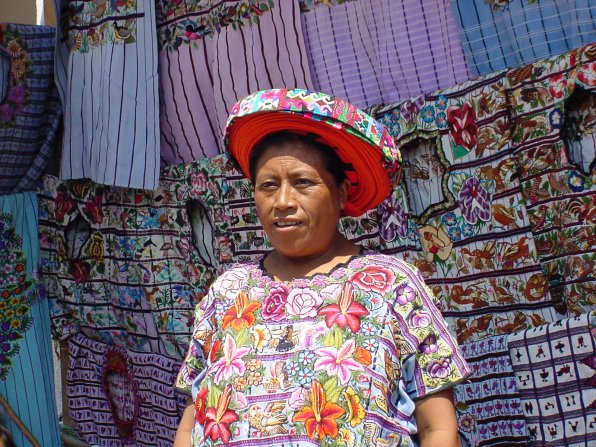
This Lady Served As:
The Model For The Image On Guatemala's Money.
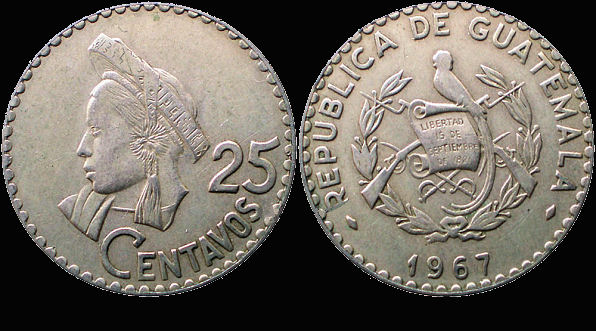
Guatemala's 25 Centavos Coin. Dated 1967.
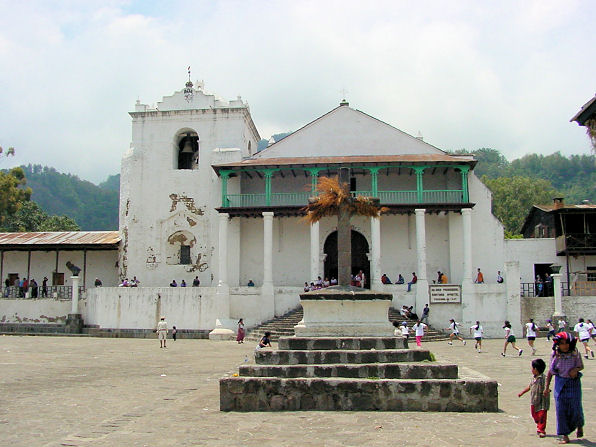
Santiago Atitlán Catholic Church.
Guatemala Highlands, Guatemala. Inside Church At Santiago Atitlán.
Mayan Cross And Catholic Cross. 
Mayan Woman.
Worshiping Mayan Godess Ixchel.
Inside Santiago Atitlán Catholic Church.
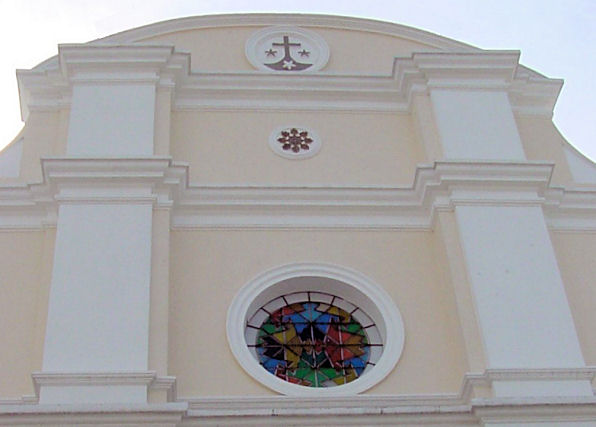
Solola Catholic Church.
Or "Church Of The Bats", Sololá.
Honors Mayan Cult Of Camazotz.
Which Began About 100 B.C.
Click Below To See Year's Supply & Emergency Items For Sale By Nitro-Pak® . No obligation !

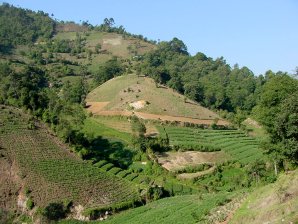
Terrace Farming.
Near Lake Atitlan. Terrace Farming.
Near Lake Atitlan. 
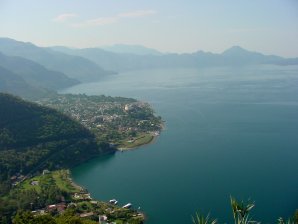
Lake Atitlán. Lake Atitlán. 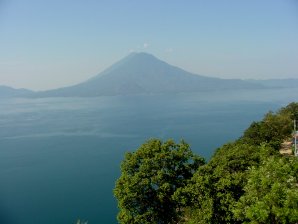
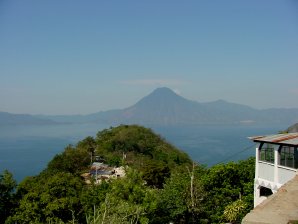
Lake Atitlán. Lake Atitlán. 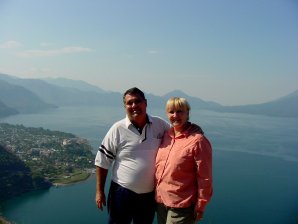
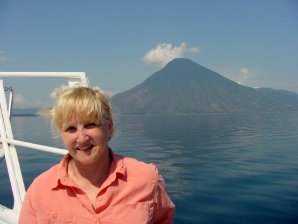
George & Audrey DeLange.
At Lake Atitlán. Audrey DeLange.
At Lake Atitlán. 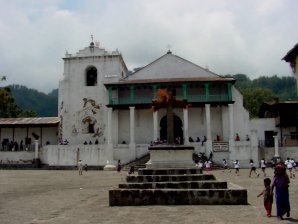
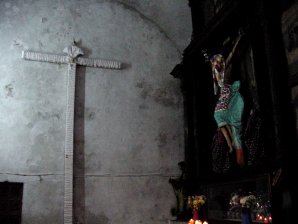
Church At Santiago Atitlán. Inside Church.
At Santiago Atitlán.
Mayan Cross & Catholic Cross. 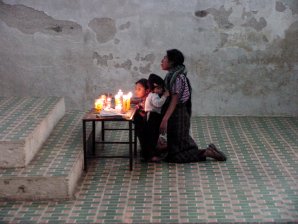
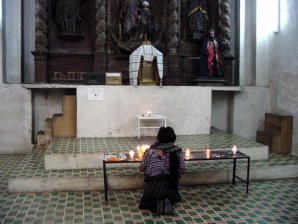
Inside Catholic Church.
At Santiago Atitlán.
Mayan Woman Worshiping
Godess Ixchel. Inside Catholic Church.
At Santiago Atitlán.
Mayan Woman Worshiping
Godess Ixchel. 
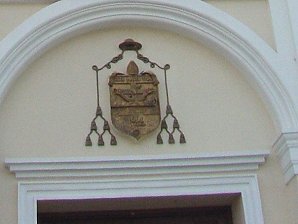
Solola Catholic Church Or
"Church Of The Bats", Sololá.
Honors Mayan Cult
Of Camazotz.
Which Began In 100 B.C. Solola Catholic Church Or
"Church Of The Bats", Sololá.
Honors Mayan Cult
Of Camazotz.
Which Began In 100 B.C. 
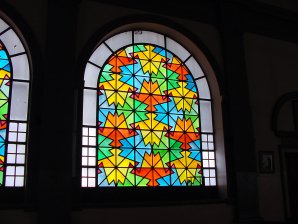
Solola Catholic Church Or
"Church Of The Bats", Sololá.
Honors Mayan Cult
Of Camazotz.
Which Began In 100 B.C. Solola Catholic Church Or
"Church Of The Bats", Sololá.
Honors Mayan Cult
Of Camazotz.
Which Began In 100 B.C.
Sololá Has A Strong Bat Cult. 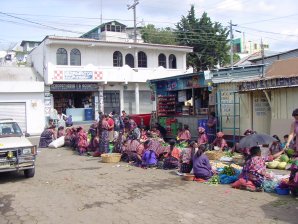
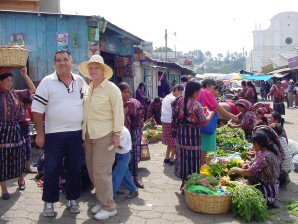
Market Day At Sololá. George & Audrey DeLange
At Market Day In Sololá. 

Market Day At Sololá. Lake Atitlán From
Hotel Jardines del Lago.
Send E-Mail to: George DeLange: [email protected]
View Online Copy Of The 'Popol Wuj' At Ohio State University
You Will Leave deLange.org
Click On Any Of The Following Links By Amazon.Com
For Books Or Videos About Touring In Kaminaljuyú, Guatemala City, Or Guatemala. No Obligation!
Click Link Below For The
Guatemala Highlands Pages!
The Guatemalan Highlands is an upland region in southern Guatemala, lying between the Sierra Madre de Chiapas to the south and the Petén lowlands to the north. The highland are made up of a series of high valleys enclosed by mountains. The native name for the region is Altos, meaning highlands, which includes the northern declivity of the Sierra Madre. The mean elevation is greatest in the west (Altos of Quezaltenango) and least in the east (Altos of Guatemala). Santiago Atitlán: Santiago Atitlán is located south of Panajachel, on the opposite side of Lake Atitlán. It is near to Tolimán ( 10,368 feet) and Atitlán (11,604 feet) volcanoes, adjacent to Santiago Bay, and looking in front of San Pedro (9,908 feet) volcano. The village of Santiago still keeps its personality and traditional culture, in spite of all of the changes endured by the village by its contract with the outer world. The local language spoken is still Tzutuhil, which belongs to the Mayan family of languages. The local people still dress up in their regional clothes. The men wear a white knee-high short pair of pants with purple stripes which is fastened with a long waistband, and a long-sleeve shirt. The women wear beautiful white wool huipiles (blouses) with vertical red and purple stripes; these have geometrical designs of birds embroidered onto the fabric. The cortes (or skirts) are a long piece of fabric rolled around the body, with colorful designs, and a multicolored band of fabric called a “tocoyal” measuring about 20 meters long that is rolled around the head, simulating a radiant sun. A practice that is a shock to many foreign visitors, who have been told that Catholicism is the local religion is that a great number of people who live in Santiago Atitlán practice a form of popular Mayan Catholicism. It is called “La costumbre” (The custom). This form of religion is a mixture between the medieval Catholicism introduced by the Spaniards during the sixteenth century and the pre-Hispanic original Mayan people. You will see examples of La Costumbre during the religious rituals of the village, such as processions and traditional dances. The sajorines or Mayan priests are the ones in charge of guiding their community ensuring that the public rituals be preserved. The passing on of the ancient Maya-Tzutuhil culture depends on them and on their deep knowledge of cosmology and wisdom. You can learn more of this part of their lives if you visit some of the cofradías in Santiago, especially the Santa Cruz cofradía, where Maximón is worshipped. Maximón (Mah-shee-MOAN is the blending of an ancient Mayan god, Judas Iscariote, and Saint Simon. The people of Santiago Atitlán call him Don Pedro de Alvarado or simply “old man”. When you visit Santiago, it is best during the Christmas Season so you can see all of this amidst Christmas lights, copal resin mist, incense smoke and candles, and under the watchful eyes of at least 2 - 5 members of the brotherhood. You will see how pilgrims pray and make flower offerings to the pagan saint, as well as beer, alcohol, fruits, tobacco and money. An interesting landmark of Santiago Atitlán is the Santiago Apóstol Church, which was built in 1547. It is filled with saints dressed in the community’s traditional clothes. You will also see that the church pulpit has pagan decor showing Yun Kax, the god of corn. Santiago Atitlán’s annual fair in honor of the patron saint Santiago Apóstol is observed every July 25th. Here you can watch the Dance of the Conquest and the long procession with the effigy of saint Santiago Apóstol. Another important festival is during Easter Week Easter Week is when the cult of Maximón places Maximón in his chapel from Wednesday to Good Friday. Then there is a reenactment of the Passion of Christ takes place on Good Thursday, Then the Nazarene Jesus procession takes place in the morning of Good Friday, and the other procession of the Holy Burial takes place in the afternoon. Sololá: Sololá is the capital city of the department of Sololá and is located about 85 miles from Guatemala City. Sololá is the land of the Cackchiquel, Quiché, and Tzutuhil people, all of which are direct descendants of the Mayan’s. The origins of Sololá can be found in the annals of the Cackchiquel people ( the Sololá Memorials), which are a chronicle written at the end of the sixteenth century that describes the history of the Cakchiquel people, before and after the Spanish conquest. Sololá was founded in 1541, the same year its Cathedral was built. At that time the inhabitants of an ancient city bearing the same name moved to the Lake Atitlán basin. The new village became known as Tecpán Atitlán. Later on the Catholic friars christened the village as, “Nuestra Señora de la Asunción de Sololá.” When you visit Sololá, you will see that it is still one of the few villages from the highlands where its people proudly wear their traditional clothing which displays the social and economic status and their position in their civil and religious hierarchies. The women wear the traditional huipil with its red stripes, a dark-blue corte (skirt) with embroidered stripes of many colors, with a waist band and the Tzute or shawl. The village men wear a white shirt and a wool jacket with a (bat embroidered on the back), remember the Bat God and the symbol of the last Cackchiquel dynasty. They also wear striped trousers with black wool over the pants, a waistband, an apron and tzute, a black felt or straw hat, a wool shoulder bag (moral), and leather sandals. On Tuesdays and Fridays, small boats and canoes loaded with people from the neighboring villages of arrive at Panajachel. The boats are also filled with all sorts of products from the neighboring villages of Lake Atitlán. From Panajachel, they start their walk uphill to Sololá in order to sell their products at the Sololá plaza market. From August 7th to the 17th of each year, Sololá has its main fair days. This is a great time to visit and see Sololá’s rich traditions and folklore. Of special interest is an event on August 15th called “Nim-Akij Sololá”, which means “Big Day of Sololá”. Lake Atitlán: Atitlán (Lago de Atitlán) is a large lake in the Guatemalan Highlands. It is also the deepest lake in Central America. However, no one knows exactly how deep it is. It is estimated at about 1116 feet. Lake Atitlán has three volcanoes on its southern flank. Several small towns and villages of the Maya people surround the lake.
|
We suggest getting a hotel in Guatemala and then letting them arrange either a car or a tour of Guatemala. We prefer Clark Tours, who have been in business for over 80 years. If you call the hotels Concierge Services ahead of your arrival, all of this can be pre-arranged for you. We do this all the time, when traveling in Guatemala. It is safe and it works!!! We have never experienced a problem doing it this way! La Aurora International Airport (IATA: GUA, ICAO: MGGT) serves Guatemala City, Guatemala. It is located 6 km south of Guatemala City's center and 25 km from Antigua. It is administered by the Direccion General de Aeronautica Civil. You can take a taxi from the airport to Antigua but we highly recommend that you contact the hotel/villa where you are staying and have them arrange for a shuttle to pick you up from the airport and take you to Antigua. The cost is about $30 including tip. You can do the same on your way back to the airport. Therefore, we have placed a link to Priceline.Com on this page so you can arrange your flights into and out of Guatemala; as well as your hotel, when visiting this area.
|
| This Link Is To Clark Tours In Guatemala. You Will Leave deLange.org
|
 |
| This Lady Served As: The Model For The Image On Guatemala's Money. |
|---|
 |
| Guatemala's 25 Centavos Coin. Dated 1967. |
|---|
 |
| Santiago Atitlán Catholic Church. Guatemala Highlands, Guatemala. |
|---|
| Inside Church At Santiago Atitlán. Mayan Cross And Catholic Cross. |
 |
| Mayan Woman. Worshiping Mayan Godess Ixchel. Inside Santiago Atitlán Catholic Church. |
 |
| Solola Catholic Church. Or "Church Of The Bats", Sololá. Honors Mayan Cult Of Camazotz. Which Began About 100 B.C. |
|---|
 |  |
| Terrace Farming. Near Lake Atitlan. | Terrace Farming. Near Lake Atitlan. |
|---|---|
 |  |
| Lake Atitlán. | Lake Atitlán. |
 |  |
| Lake Atitlán. | Lake Atitlán. |
 |  |
| George & Audrey DeLange. At Lake Atitlán. | Audrey DeLange. At Lake Atitlán. |
 |  |
| Church At Santiago Atitlán. | Inside Church. At Santiago Atitlán. Mayan Cross & Catholic Cross. |
 |  |
| Inside Catholic Church. At Santiago Atitlán. Mayan Woman Worshiping Godess Ixchel. | Inside Catholic Church. At Santiago Atitlán. Mayan Woman Worshiping Godess Ixchel. |
 |  |
| Solola Catholic Church Or "Church Of The Bats", Sololá. Honors Mayan Cult Of Camazotz. Which Began In 100 B.C. | Solola Catholic Church Or "Church Of The Bats", Sololá. Honors Mayan Cult Of Camazotz. Which Began In 100 B.C. |
 |  |
| Solola Catholic Church Or "Church Of The Bats", Sololá. Honors Mayan Cult Of Camazotz. Which Began In 100 B.C. | Solola Catholic Church Or "Church Of The Bats", Sololá. Honors Mayan Cult Of Camazotz. Which Began In 100 B.C. Sololá Has A Strong Bat Cult. |
 |  |
| Market Day At Sololá. | George & Audrey DeLange At Market Day In Sololá. |
 |  |
| Market Day At Sololá. | Lake Atitlán From Hotel Jardines del Lago. |
| View Online Copy Of The 'Popol Wuj' At Ohio State University You Will Leave deLange.org
|
Click On Any Of The Following Links By Amazon.Com
For Books Or Videos About Touring In Kaminaljuyú, Guatemala City, Or Guatemala. No Obligation!
Click Link Below For The
Guatemala Highlands Pages!



